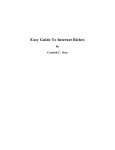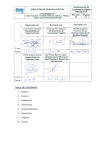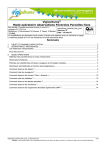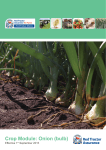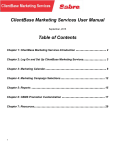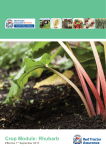Download (MICoR) Plants User Guide
Transcript
PLANT EXPORTS Manual of Importing Country Requirements (MICoR) Plants User Guide Contents Glossary of terms .................................................................................................................................... 3 Introduction ............................................................................................................................................ 4 Purpose ................................................................................................................................................... 4 Tips .......................................................................................................................................................... 4 Searching in MICoR Plants ...................................................................................................................... 6 Simple search ...................................................................................................................................... 6 Search by scientific/common name.................................................................................................. 11 Advanced search options .................................................................................................................. 12 Using the Search ICRs option: ........................................................................................................... 12 Using the Advanced Search option: .................................................................................................. 13 All ICRs search options ...................................................................................................................... 14 Documents ............................................................................................................................................ 16 Subscribe to RSS feed............................................................................................................................ 19 Frequently Asked Questions (FAQ’s) .................................................................................................... 21 Support ................................................................................................................................................. 23 VERSION DATE REASON FOR ISSUE AUTHOR/S 0.1 19/2/13 Creation of first version B. Beacham/L. Edwards 0.2 April 2013 Update of content B Beacham 0.3 May 2013 Inclusion of regional office feedback B. Beacham/L. Edwards 0.4 September 2013 Update web address on support page B Beacham MICoR Plants – User Guide 2013 2 Glossary of terms DAFF: ICR: ISO: MICoR: NPPO: RSS: Department of Agriculture, Fisheries and Forestry Importing Country Requirement International Organization for Standardisation Manual of Importing Requirements National Plant Protection Organization Rich Site Summary MICoR Plants – User Guide 2013 3 Introduction The Manual of Importing Country Requirements (MICoR) Plants is DAFF Plant Exports’ current database that publishes known importing country requirements and is used by stakeholders (industry, exporters, importing National Plant Protection Organisations and staff) to check / verify requirements relating to plant commodities to be exported from Australia and is the source for approved and consistent wording of additional declarations/endorsements. The database is provided for general information only, and you should independently verify the information in the database before relying on it. While the Commonwealth has processes in place for updating the database and correcting errors that are found, the database may be subject to change at any time without notice and will not necessarily contain the most accurate or up-to-date information. The data published in MICoR Plants is sourced from the latest known conditions of the National Plant Protection Organisation (NPPO), obtained through a number of avenues including import permits or other official documents, which are supplied to [email protected] . Where there are no Importing Country Requirements (ICRs), it is the responsibility of the exporter (or their agent) to obtain official notification in writing from the Importing Plant Protection Organisation (import permit or instrument in writing) and email MICoR Plants: [email protected] for assessment/updating of the database. Any notification received which differs to that in MICoR Plants is to be emailed to MICoR Plants [email protected] for assessment/updating of the database. Purpose The purpose of this user guide is to assist users in using the MICoR Plants system Tips Less is more! Start with basic information like a Country and Group/End use, then refine your search and add more details if there are too many results. When searching within MICoR Plants, the term ‘consumption’ within the ‘end use’ list is only applicable to grains/seeds. For the following End Use descriptions, a Group description is not associated: - Logs - Processed timber - Stockfeed - Timber - Wood Packaging - Woodchips - Growing media For the following Group descriptions, an End Use description is not associated: - Nuts - Processed plant products - Cut flowers – fresh - Cut foliage – fresh MICoR Plants – User Guide 2013 4 The following are classed as fruits (as they develop from a flower) and any specifically listed conditions or generic Phytosanitary case conditions apply: . Avocado . Capsicum . Chillies . Cucumber . Eggplant . Melons . Olives . Pumpkin . Squash . Tomato . Zucchini A ‘PDF’ version of your search results is available by selecting the ‘PDF’ icon toward the top of the screen, as per the example below. MICoR Plants – User Guide 2013 5 Searching in MICoR Plants There are two search options in MICoR Plants – a ‘simple’ search and an ‘advanced’ search. Simple search The Simple Search fields are located on the MICoR Plants home page Select the ‘Country’, ‘Group’ and ‘End use’ from the respective drop-down lists and click on ‘submit’. MICoR Plants – User Guide 2013 6 The following is an example of a search for fruit to India. Select from the drop down lists: country – India, Group – Fruit, End use – Fresh and click on ‘submit’: MICoR Plants – User Guide 2013 7 The results of the search criteria will be displayed: If too many results, the search criteria can be refined – details are provided at Search by scientific / common name – page 9. Where import conditions are the same for all products within the group/end use, the ICR ‘name’ will be ‘ALL’. Where import conditions are the same for most products within the group/end use, the ICR ‘name’ will be ‘OTHER’. Click on the hyperlink of the applicable ICR to view full details. MICoR Plants – User Guide 2013 8 The Importing Country Requirement will contain all, or some of the following: 1 2 4 3 5 6 7. 8. 9. MICoR Plants – User Guide 2013 9 ICR details page continued: 10 11 12 1. 2. 3. 4. 5. 6. 7. Country ISO Country code Botanical and/or common name Group and/or End use “jump to” page hyperlinks NPPO details (if known), including web address General documentation requirements - Information to assist exporters and DAFF inspectors in relation to activities that need to be fulfilled to meet importing country requirements enabling export inspections to occur and certification to be issued. 8. Treatment documentation requirements - Information to assist exporters and DAFF inspectors in relation to product treatment requirements, particularly those that need to be certified by DAFF for export certification. 9. Additional Declaration/Endorsements - The text that will be certified on the Phytosanitary Certificate to attest to specific pest/disease requirements of the importing NPPO. Any variation to this text is not permitted without approval from either MICoR Plants or the Program Manager, Canberra. 10. Reference - details of where information was sourced / obtained from MICoR Plants – User Guide 2013 10 11. Date the ICR was initially created 12. Date the ICR was reviewed Search by scientific/common name If there are too many results from the ‘simple’ search, it can be refined by entering either the scientific or common name into the ‘scientific/common name’ field. For example, select the country – Taiwan, and type broccoli in the ‘scientific/common name’ and select ‘submit’ as per the example below: Where the word is found throughout the ICRs text, MICoR Plants will list all of these ICRs. The results of the search criteria will be displayed: MICoR Plants – User Guide 2013 11 Advanced search options Using the Search ICRs option: Type in the key word / words and a search will be undertaken in all ICRs for the specified word / words. Note – the search is undertaken on all content of the ICR. Eg: General text, Treatment text, Additional Declaration/Endorsements text Example shown is for the text methyl bromide and the corresponding results: MICoR Plants – User Guide 2013 12 Using the Advanced Search option: The ‘advanced’ search function enables searching at a more detailed level. From the home page, select ‘Advanced search’. Complete the Advanced Search screen with the details required. Example shown is for Ditylenchus dipsaci for solanum for all countries, groups and end use and the corresponding results: The results of the search criteria are: Click on each ICR hyperlink to view the details. MICoR Plants – User Guide 2013 13 All ICRs search options To view the lists of all ICRs for a country, click on the country in the ICR pathway located on each ICR content page. All ICRs for the country, including Group and End-use, will be displayed in alphabetical order (Continuation of list on next page ...) MICoR Plants – User Guide 2013 14 (list continues to end of alphabet on next page ...) MICoR Plants – User Guide 2013 15 Documents MICoR Plants also publishes documents which are relevant to plant exports that are not country or commodity specific. It also includes protocols and workplans for those commodities in which there is a bilateral agreement between DAFF and the importing country NPPO. Select the ‘View the documents’ link. MICoR Plants – User Guide 2013 16 1 2 3 The documents listed under the ‘Documents’ (1) heading are publicly available – stakeholders do not require a log-on / password to access. The documents listed under the ‘Protocols’ (2) and ‘Workplans’ (3) headings are not publicly available – stakeholders require a log-on / password to access. To gain access to information about Protocols and Workplans, click on the ‘register with Plant Exports’ link: MICoR Plants – User Guide 2013 17 Complete your details as per the following example, then click on ‘submit’: You will be emailed a user name and password. Once access has been given, on the Documents page select to view either the Protocols or view the Workplans (you have access to both sections). MICoR Plants – User Guide 2013 18 The logon screen will appear: Enter your user name and password as provided; you will then be able to access the protocols/workplans information. You can change or edit your password as follows: • • Once you are logged in, click on your name which is located at the top left hand of the page under the Australian government logo and the edit details screen will appear with your details pre-populated in the fields. You can change your password or your contact details once you are in this screen. When you have completed updating your details, click the commit button to save your changes. If you experience any problems, please email: [email protected] Subscribe to RSS feed RSS stands for Rich Site Summary and is an Internet technology standard that allows you to receive updates to web-based content of interest. Subscribing to the RSS feed will enable you to automatically receive updates to importing country requirements as soon as they become available. Rather than being notified of website updates by ezines or email, RSS feeds give you complete control. There is no requirement to reveal your email address and you can stop receiving content without requesting to be “taken off the list.” Your privacy is maintained as there is no email address involved and therefore no way a publisher can sell, rent or disclose your contact details. You are also protected from spam, viruses, phishing, or identity theft. You can unsubscribe at any time. MICoR Plants – User Guide 2013 19 To subscribe to RSS feed, click on the Subscribe to RSS feed link located on the MICoR Plants home page. Using the drop down lists, select the criteria for which the RSS subscription is required. Eg: Grains / Seeds for consumption to all countries: Or Fruit (fresh) to Taiwan MICoR Plants – User Guide 2013 20 If multiple Groups, End use and / or Countries are required, separate submissions will need to be made. Send the request by clicking the ‘Subscribe’ icon. To view updates at any time, check the RSS icon on the Windows Internet Explorer tool bar Updates will be obtainable through this link when they are available. An RSS document (which is called a ‘feed’, ‘web feed’, or ‘channel’) includes full or summarised text and other data such as publishing dates and authorship. If you experience any problems, please email: [email protected] Frequently Asked Questions (FAQ’s) A number of frequently asked questions appear within MICoR Plants and can be accessed through the ‘FAQ’ link on the home page. Click on the relevant link for an answer to that question. MICoR Plants – User Guide 2013 21 To view the content of a particular question, click on the link: MICoR Plants – User Guide 2013 22 Support For additional assistance on the use of MICoR Plants and contact details, click on the ‘Support’ link on the home page. MICoR Plants – User Guide 2013 23























